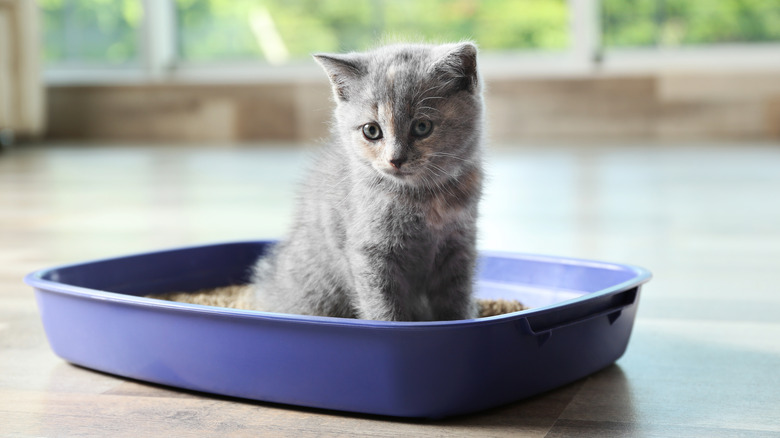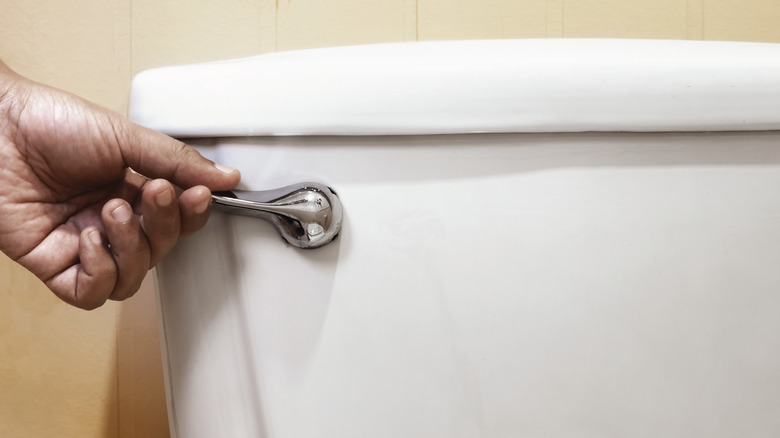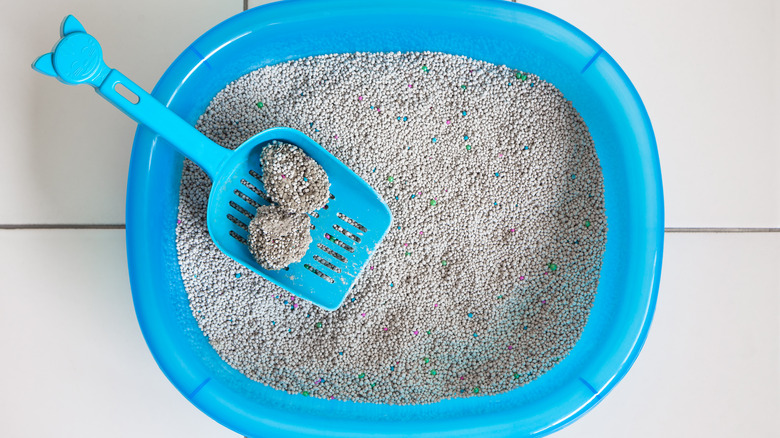What Happens If You Put Kitty Litter In The Toilet?
If you have a cat, you probably know how annoying it can be to clean the litter box regularly. It can be tempting to take that dirty litter and dump it in the toilet to make the unpleasant job a bit easier, but should you? Before exploring what happens when you flush litter down the toilet, it's important to be aware of the different types of litter on the market. Nowadays, you have various options to choose from based on your personal preferences and those of your beloved pet. You can choose between clumping and non-clumping clay, paper, wheat, grass, walnut shell, silica gel, and pine, as per The Spruce Pets. Some natural litter, such as wheat or grass, is advertised as flushable due to its breakable nature when mixed with water. Others, like clay, will warn you not to flush.
Perhaps at this point, you're thinking that you'll run out and purchase a flushable variety of cat litter to make the chore easier. But don't dash off just yet. There are issues associated with both flushable and non-flushable types of litter that you'll want to take note of before deciding how to throw it out.
This is what happens when you flush cat litter down the toilet
According to Incredible Kitty, you should never flush clay or silica based cat litter down the toilet. These cat litters are designed to absorb liquids and expand, risking major clogs in your plumbing system. While you might not notice a clog after one flush, the litter can build up in the pipes over time. If you flush enough cat litter down the toilet, you will likely have to shell out thousands of dollars to repair the damaged pipes, not to mention the amount of time and work it will take for plumbers to expose the lines and switch them out.
If you're thinking you will instead grab one of the natural, flushable varieties of cat litter, you may want to think twice about that as well. While you may not have to face clogged pipes, you might risk several health issues caused by exposure to cat feces. The Environmental Protection Agency points out that the viruses, bacteria, and parasites present in cat waste can harm the ecosystem and wildlife in the area that the water is being pumped into. Ultimately, it's best just to avoid flushing cat litter altogether to keep your plumbing clog-free and avoid polluting the environment.
The most environmentally friendly way to dispose of cat litter
While flushing cat litter is a big no-no, there are tried and true disposal methods that will protect your plumbing and the environment at the same time. Treehugger advises cat parents to scoop urine and feces into a garbage bag and seal it tightly before tossing it with the rest of your garbage. Make sure you double bag the dirty litter to avoid any potential leakage that can contaminate your home or the environment with the bacteria and parasites present in cat feces. This disposal process shouldn't take much longer than it would for you to dump the contents of the litter box down the toilet, and you'll be able to rest assured knowing that no harm will come to your home or wallet. You'll also want to avoid burning cat litter if you typically burn your garbage on your property, since litter doesn't burn well and will collect at the bottom of the barrel.
Suppose you want to go the extra mile to be green. In that case, Treehugger mentions that non-soiled cat litter made from natural materials, including wheat, corn, pine, and walnut shells, can be safely composted if you already have a DIY compost system set up. Even if the litter appears clean, you should still take care not to compost it near water sources or vegetable gardens where it may come in contact with food that you (or wild critters) will later consume.


